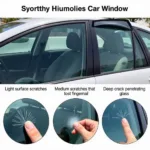Car paint defects, from minor scratches to significant clear coat damage, can detract from your car’s appearance and potentially affect its resale value. Learning how to repair car paint defects yourself can save you money and keep your car looking its best. This guide will provide a comprehensive overview of common car paint defects and how to address them.
Repairing car paint defects requires careful assessment and the right approach. Minor scratches often respond well to polishing, while deeper damage may require touch-up paint or even professional intervention. Understanding the nature of the defect is crucial for effective repair. For example, if bird droppings have etched into your paint, you might want to check out resources on repair bird droppings on car paint.
Identifying Common Car Paint Defects
Identifying the specific type of car paint defect is the first step toward a successful repair. Common defects include scratches, swirl marks, chips, clear coat peeling, oxidation, and etching.
Scratches and Swirl Marks
Scratches are usually caused by sharp objects scraping against the paint, while swirl marks are fine scratches often resulting from improper washing and drying techniques. These are typically superficial and can be addressed with polishing compounds.
Chips and Peeling Clear Coat
Chips are deeper than scratches and expose the underlying paint layers, making them susceptible to rust. Peeling clear coat occurs when the protective top layer deteriorates due to UV exposure and environmental factors.
Oxidation and Etching
Oxidation is a chemical reaction that dulls the paint and gives it a faded appearance. Etching is caused by acidic substances like bird droppings or tree sap that eat into the clear coat. If you’re dealing with peeling paint, you can find helpful information on how to repair peeling paint on my car.
 Identifying Common Car Paint Defects like Scratches, Swirl Marks, Chips, and Peeling Clear Coat
Identifying Common Car Paint Defects like Scratches, Swirl Marks, Chips, and Peeling Clear Coat
How to Repair Minor Car Paint Defects: Scratches and Swirl Marks
Minor scratches and swirl marks can often be removed with polishing compound and a microfiber cloth. Apply a small amount of compound to the affected area and work it in using circular motions. Buff off the residue with a clean microfiber cloth.
What if the scratch is deeper?
If the scratch is deeper than the clear coat, you may need to use touch-up paint. Clean the area thoroughly, apply the touch-up paint carefully, and allow it to dry completely. You can then polish the area to blend the repair with the surrounding paint.
How to Repair Major Car Paint Defects: Chips and Peeling Clear Coat
Repairing chips and peeling clear coat requires more extensive work. For chips, you’ll need to sand the area smooth, apply primer, and then touch-up paint. If you’re dealing with bird dropping damage, consider looking into bird droppings car paint repair. For peeling clear coat, sanding and repainting the affected area may be necessary.
Should I wet sand the area?
Wet sanding can be effective for smoothing out rough areas and blending repairs. If you choose to wet sand, use a fine-grit sandpaper and plenty of water to avoid further damaging the paint. You can find more information on wet sanding techniques specifically for bird dropping damage at bird droppings car paint repair wetsand.
Preventing Future Car Paint Defects
Preventing car paint defects is easier than repairing them. Regular washing and waxing, parking in shaded areas, and using a car cover can help protect your car’s paint from damage. If bird droppings are a concern, addressing them quickly can minimize damage. For more specific advice on this, check out resources on car paint bird droppings damage repair.
Conclusion
Repairing car paint defects can seem daunting, but with the right knowledge and tools, you can often restore your car’s finish to its former glory. By understanding the types of defects and the appropriate repair techniques, you can keep your car looking its best while saving money on professional repairs. Remember, regular maintenance and preventative measures are key to minimizing future car paint defects.
FAQ
- What is the best way to remove swirl marks? Polishing compound and a microfiber cloth are usually effective for removing swirl marks.
- How do I repair a deep scratch in my car’s paint? Deep scratches may require touch-up paint and sanding to achieve a smooth finish.
- Can I repair peeling clear coat myself? Yes, but it requires careful sanding and repainting.
- What causes car paint to oxidize? Oxidation is a chemical reaction caused by exposure to sunlight, air, and pollutants.
- How do I prevent bird droppings from damaging my car’s paint? Removing bird droppings promptly and using a car cover can help protect your paint.
- What’s the difference between a scratch and a chip? A chip is deeper and exposes the underlying paint layers, while a scratch is usually superficial.
- How often should I wax my car? Waxing every few months can help protect your car’s paint and maintain its shine.
Need help with your car repair? Contact us via WhatsApp: +1(641)206-8880 or Email: [email protected]. Our customer service team is available 24/7.

